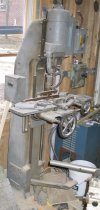For a reasonI think you can find benchtop hollow chisel mortisers on Craigslist for under $200 quite frequently.
You are using an out of date browser. It may not display this or other websites correctly.
You should upgrade or use an alternative browser.
You should upgrade or use an alternative browser.
Mortise chisel vs. Mortise machine vs. Mortise adpter for drill press
- Thread starter Westpacx3
- Start date
I have an older Delta drill press mounted mortising attachment. Will let you have it on the cheap if you're interested, it is a 17-905 model. It is still in the original packaging and has not been used by me if ever.
As you probably know, Paul Sellers does mortising with ordinary bevel chisels (or maybe firmer - my eyes are bad), and even says mortise chisels aren't necessary. That said, I've used my bevel edged Marples, as well as a Narex mortise chisel and a pigsticker of unknown origin. Can't say I felt any difference. Go slow, take little nibbles. I try to follow Seller's recommendations. I did see someone using a 1-2-3 block as a vertical guide in a video recently and plan to try that the next time I make a mortise.
Thanks, I'll let you know. Right now this is a practice project and my aprons are now too thin for the 3/8 I had planned to use, the wood was free from a cabinet shop and i had to remill it some. I will have to use my firmer chisel that I had practiced with on this project for now so the debate as to what to do will be postponed a bit. Some have said the drill press does not produce enough pressure and I assume if it did then a quality bit would be needed and the game gets upped a little more.I have an older Delta drill press mounted mortising attachment. Will let you have it on the cheap if you're interested, it is a 17-905 model. It is still in the original packaging and has not been used by me if ever.
I'll finish this project and see where it goes. I appreciate the offer. By the way, does it come with the bits?
That's interesting. We have a wysong in the family back in the early 1800s from Fincastle VA area. Might be the same familyHere's a foot-operated Wysong and Miles 321 that I picked up at an auction decades back for $250.00±. Sold it real quick and got well on the deal. Their model 284 seems to be the industry standard for a good mortiser. I mention these to establish just how high the bar is for a quality mortiser.
View attachment 228417
Thanks, I saw that video last night. Very encouraging. I am beginning to see that skill and patients with a basic tool can Perform as well or close to higher tech stuff. Kinda like folks buying a golf game versus practicing more. No offense to golfers, I bought some golf tech years ago as well...lolAs you probably know, Paul Sellers does mortising with ordinary bevel chisels (or maybe firmer - my eyes are bad), and even says mortise chisels aren't necessary. That said, I've used my bevel edged Marples, as well as a Narex mortise chisel and a pigsticker of unknown origin. Can't say I felt any difference. Go slow, take little nibbles. I try to follow Seller's recommendations. I did see someone using a 1-2-3 block as a vertical guide in a video recently and plan to try that the next time I make a mortise.
Dave--the reason for squaring off mortise ends is if you don't you wind up with 2 large pockets that don't offer any support. They just fill up with glue when you assemble. The glue that fills the cavity when wet will shrink when it dries. If your piece, when used, puts any lengthwise stress on the tenon (I hope that explains itself because I don't know how to explain it otherwise), over time the dried glue will get crushed into powder and the joint will fail. Think chair leg support rails; that's where most chairs break/fall apart first.I use a jig, a plunge router and an outrigger on each side. I do not square off the ends as it is not really necessary and strikes me as OCD
I have a delta drill press mortising attachment, its yours if you want to drive to lexington
Wiley, thanks for the tip but I simply dont agree. First of all, there is not a huge gap at end of mortise, it is simply rounded vs squared. Secondly, if building a table the tenons are a good 4 to 5inches wide and offer plenty of gluing surface. This more than compensates for the tiny gap around the end of the tenons.Dave--the reason for squaring off mortise ends is if you don't you wind up with 2 large pockets that don't offer any support. They just fill up with glue when you assemble. The glue that fills the cavity when wet will shrink when it dries. If your piece, when used, puts any lengthwise stress on the tenon (I hope that explains itself because I don't know how to explain it otherwise), over time the dried glue will get crushed into powder and the joint will fail. Think chair leg support rails; that's where most chairs break/fall apart first.
LATEST FOR SALE LISTINGS
-
-
-
SOLD -- $75: Gast moa v113 Vacuum Pump Veneer, 60" bag and board
- Started by peterdnight
- Replies: 1
-
GONE: Gladiator 5 cleats, 10 hangers, Paper Towel and Shelf
- Started by peterdnight
- Replies: 3
-
SOLD -- $100 Makita mac700 portable air + grex pin nailer + 2 others + 50' hose
- Started by peterdnight
- Replies: 1

